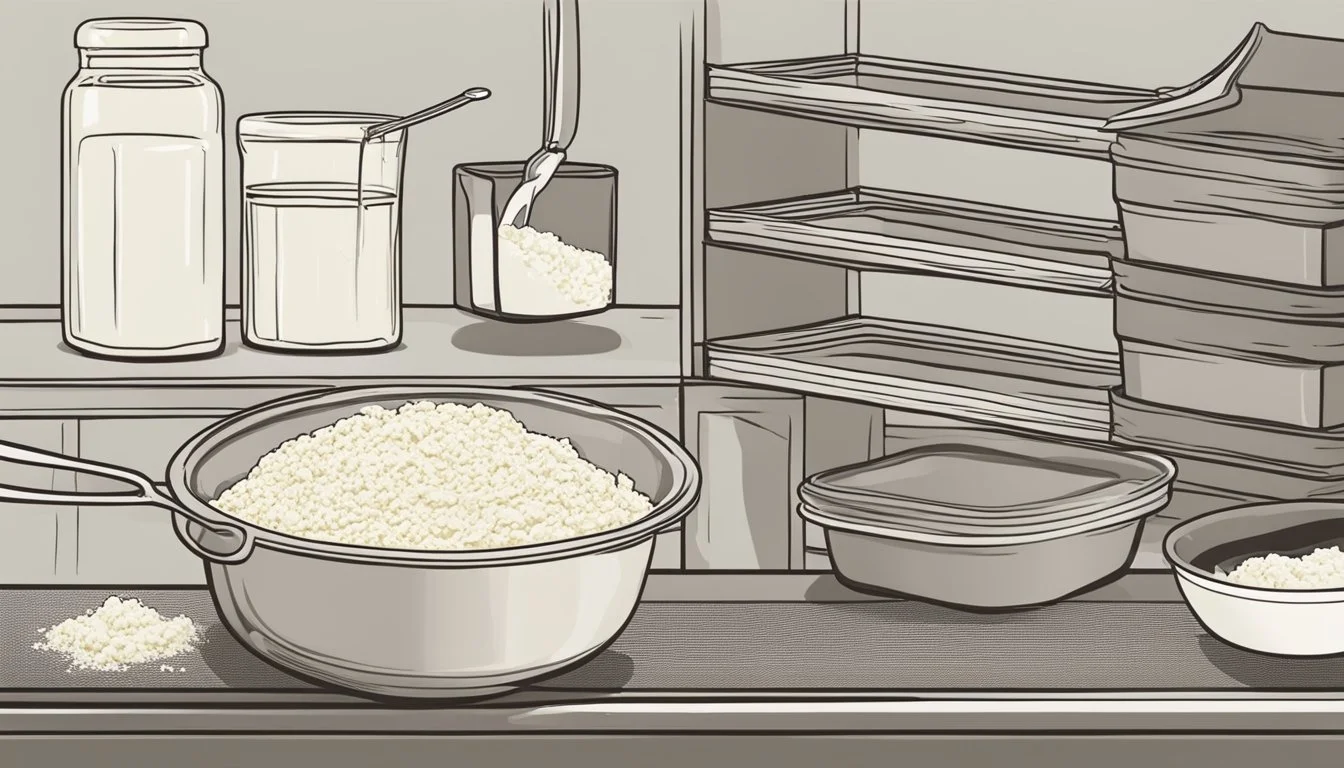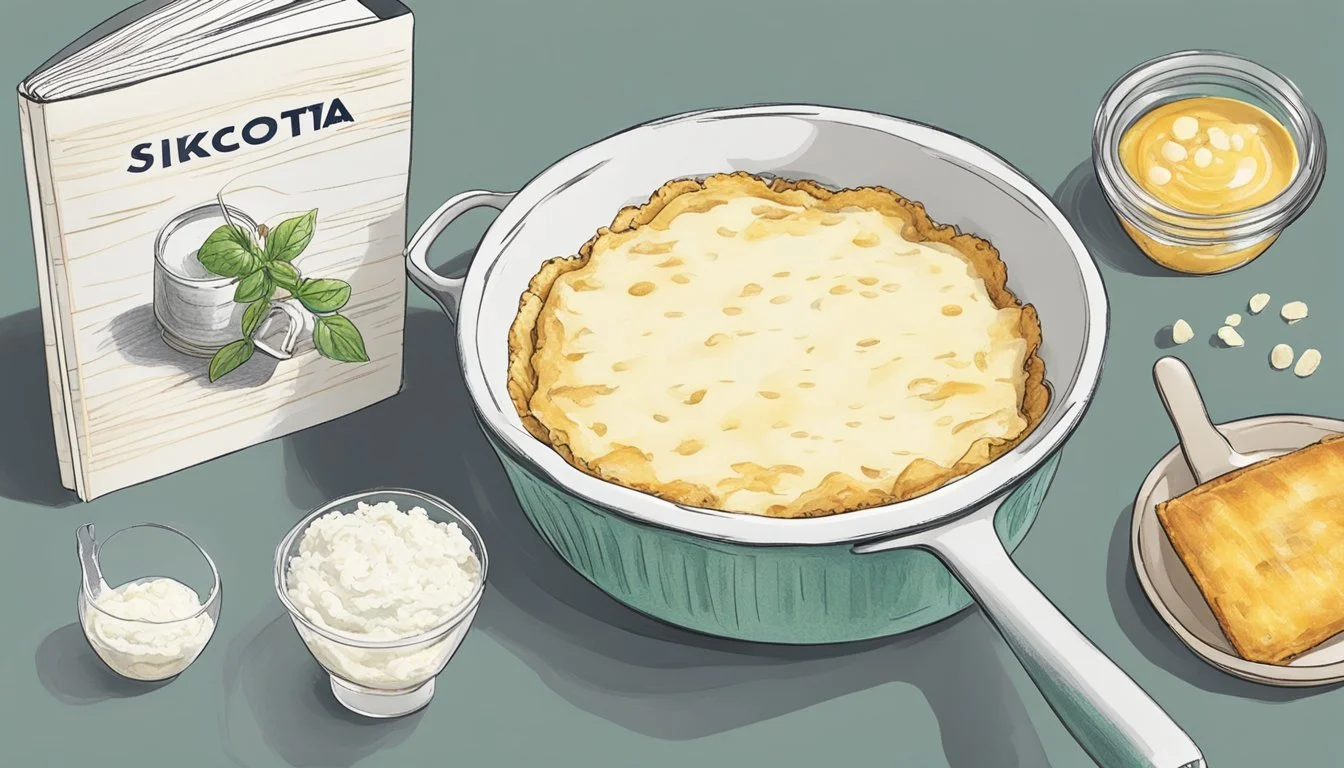How to Substitute Skim Ricotta for Whole Ricotta in Lasagna
A Seamless Swap Guide
Substituting skim ricotta for whole ricotta in lasagna is a common consideration for those looking to reduce the dish's fat content without sacrificing texture or flavor. Ricotta cheese (how long does cheese last?), known for its creamy and slightly granular texture, plays a pivotal role in imparting lasagna with its characteristic richness. Whole ricotta cheese, made with full-fat milk, contributes a dense and smooth consistency to the lasagna layers, helping to bind the ingredients together while providing a luxurious mouthfeel.
Shifting to skim ricotta, which is made from skimmed or non-fat milk, can lighten the dish significantly. Despite its lower fat content, skim ricotta can be used effectively in lasagna recipes. It retains much of the original cheese's texture, ensuring the layers in the lasagna remain moist and the flavor profiles intact. Chefs often employ skim ricotta as a healthier alternative, ensuring lasagna remains a comforting and indulgent meal while aligning with nutritional preferences or dietary requirements.
To ensure a successful substitution, it's essential to consider the moisture content and potential flavor differences between whole and skim ricotta. Skim ricotta may contain more water, which could impact the lasagna's consistency, and its milder flavor might require slight adjustments to seasoning. Tactful incorporation of skim ricotta into lasagna allows for a lighter version of the classic dish, maintaining the balance between a health-conscious approach and the satisfaction of traditional Italian cuisine.
Understanding Ricotta Cheese
Ricotta cheese is a staple in various dishes, and its fat content plays a significant role in flavor and texture. The comparison between whole and skim ricotta cheese reveals distinct nutritional profiles, which may affect the outcome in recipes like lasagna.
The Role of Fat in Ricotta
The fat content in ricotta cheese contributes to its creamy texture and rich flavor. Whole milk ricotta is made from whole milk, containing a higher fat percentage, which enhances the taste and gives it a smoother consistency that's often preferred for lasagna layers. Conversely, skim ricotta is made from skim milk, containing less fat, resulting in a lighter texture and a slightly different flavor profile.
Fat Content Comparison:
Whole Milk Ricotta: Higher fat, leading to creamier texture
Skim Ricotta: Lower fat, lighter texture but can be less flavorful
Nutritional Profile of Whole vs. Skim Ricotta
Skim ricotta cheese offers a lower-fat alternative to whole milk ricotta, which impacts its nutritional content, particularly in terms of fat, calories, and, to a lesser extent, protein and carbohydrates.
Whole Milk Ricotta:
Fat: Approximately 32 grams per cup
Calories: Roughly 428 calories per cup
Protein: Near 28 grams per cup
Carbohydrates: About 8 grams per cup
Skim Ricotta:
Fat: Reduced, roughly 19.6 grams per cup in part-skim varieties
Calories: Lowered, around 242 calories per cup for part-skim
Protein: Slightly less than whole milk ricotta
Carbohydrates: Comparable to whole milk ricotta
The protein content remains relatively high in both types, providing a satiating component to the cheese. The carbohydrate levels do not vary significantly between whole and skim ricotta.
Preparing for the Substitute
When substituting skim ricotta for whole ricotta in lasagna, one must carefully consider the differences in fat content that affect creaminess, flavor, and moisture.
Choosing the Right Skim Ricotta
Selecting the appropriate skim ricotta is paramount. One should look for brands that boast a rich flavor profile and ideal consistency for cooking. High-quality skim ricotta often has less moisture and a more compact texture than its whole milk counterpart, a factor to take into account when aiming to replicate the traditional lasagna experience.
Adjusting Creaminess and Flavor
To enhance the creaminess of skim ricotta, one might consider blending it with a small amount of low-fat milk or a liquid of choice. Flavor can also be supplemented by incorporating herbs, spices, or grated cheese like Parmesan to infuse the skim ricotta with additional depth, bridging the gap between it and whole ricotta.
Herbs and spices to add: Basil, oregano, black pepper
Cheese for depth: Grated Parmesan
Considerations for Texture and Moisture
Texture and moisture are critical factors that influence the lasagna's quality. Skim ricotta has a tendency to be grainier, which can be mitigated by straining any excess liquid and giving it a brief whisk before layering. Absorbent ingredients, such as eggs or breadcrumbs, might be used to balance the moisture content, thus ensuring the lasagna maintains its structure.
Absorbent ingredients to consider: Eggs, breadcrumbs
Substitution Techniques
When substituting skim ricotta for whole ricotta in a lasagna recipe, one must consider the proportions and consistency, additional ingredients to enhance flavor and texture, and alternative options that align with dietary preferences.
Proportion and Consistency
Using skim ricotta directly in place of whole ricotta can affect the moisture level in lasagna. To maintain the desired texture without adding extra fat:
Use a 1:1 ratio of skim to whole ricotta.
If the skim ricotta seems too watery, strain it through a fine-mesh sieve or cheesecloth to achieve a thicker consistency reminiscent of whole ricotta.
Incorporating Additional Ingredients
To replicate the richness of whole ricotta without departing from the use of skim ricotta, consider adding other ingredients:
Mix in 1 to 2 tablespoons of plain yogurt or cream cheese to enhance creaminess.
Season with herbs like basil or oregano to complement the cheese flavor.
For additional tang and depth, a small amount of goat cheese or mascarpone can be folded into the skim ricotta mixture.
Alternative Dairy and Non-Dairy Options
Some individuals might prefer or require alternatives to ricotta cheese entirely, either for health reasons or personal taste. The following substitutes can be used:
Substitute Description Cottage Cheese (how long does cottage cheese last?)Provides a similar texture and can be blended smooth; substitute in a 1:1 ratio and season as needed. Cream Cheese Offers a tangy flavor; use in smaller amounts due to its richness. Goat Cheese Adds a distinctive tang; blend with skim ricotta or use alone in a moderated quantity. Mascarpone Delivers creaminess and a mild flavor; use sparingly to avoid altering the lasagna's intended taste. Tofu (for vegans) Crumble and blend with nutritional yeast and olive oil to mimic ricotta's texture; adjust proportions to suit texture preference.
It's important to keep in mind that substitutes may alter the final taste and texture of the lasagna, so one should expect subtle differences from the traditional recipe.
Recipe Adaptations
When substituting skim ricotta for whole ricotta in lasagna, it's imperative to maintain the dish's integrity by keeping the texture and flavor profile as authentic as possible. Careful considerations can uphold the rich Italian heritage of this main course while catering to dietary preferences.
Classic Lasagna with Skim Ricotta
In a traditional lasagna, the rich, creamy layer often comes from whole ricotta. To successfully use skim ricotta instead, one needs to compensate for the lower fat content which contributes to the creaminess of the dish. A straightforward adaptation for a classic lasagna that includes layers of meat sauce, lasagna noodles, and cheese, would involve:
Sauce: If the recipe calls for a meat sauce, ensure it's rich and flavorful to balance the lighter profile of skim ricotta. The robustness of a classic tomato sauce can also be enhanced with herbs like oregano and basil.
Cheese Mixture: Mix skim ricotta with an egg to help bind the cheese and improve its consistency after baking. Adding a small amount of parmesan or pecorino cheese to the mixture can introduce depth to the flavor.
Creaminess: To mimic the creaminess of whole ricotta, consider blending the skim ricotta with a touch of béchamel sauce – a staple in Italian cuisine. This sauce, made from butter, flour, and milk, delivers silkiness without the need for additional fat.
Vegetarian and Special Diet Variations
Lasagna is versatile enough to accommodate various dietary needs without compromising taste. For vegetarian versions or those catering to special diets, skim ricotta can be used effectively with several modifications:
Noodles: Opt for whole wheat or gluten-free lasagna noodles depending on dietary restrictions.
Vegetarian Sauce: Replace meat sauce with a rich, chunky tomato sauce bursting with vegetables like zucchini, eggplant, and bell peppers for added nutrition and texture.
Dairy Substitutes: Some may wish to incorporate dairy-free cheese alternatives alongside the skim ricotta to maintain a low-fat profile while ensuring the lasagna does not dry out.
By incorporating these adaptations, one can still enjoy the quintessential layers and mouth-watering flavors of lasagna, while adhering to dietary choices or restrictions.
Cooking and Assembly Tips
When substituting skim ricotta for whole milk ricotta in lasagna, maintaining the dish's traditional texture and flavor is key. Skim ricotta offers a lower fat content, which can affect overall richness and moisture balance in the final product.
Layering the Lasagna
It's crucial to assemble the layers thoughtfully. Begin with a thin base of sauce to prevent sticking, followed by a layer of noodles. For the ricotta mixture, combine:
1 cup skim ricotta
1 beaten egg (helps with binding)
Desired seasonings (such as salt, pepper, and herbs)
Optional: steamed spinach or other vegetables for added flavor and nutrition
Spread the ricotta mixture evenly before adding a layer of ground beef or another protein, such as stuffed shells, if using. Repeat the layering process, ending with a layer of sauce and a generous sprinkle of cheese substitutes, if desired.
Cooking Time Adjustments
The total cooking time for lasagna with skim ricotta remains similar to using whole milk ricotta. However, it's essential to monitor the lasagna as it bakes to ensure that it doesn’t dry out due to the lower fat content. A standard guide for baking lasagna is:
Stage Approximate Time Initial Bake (covered) 25 minutes at 375°F Final Bake (uncovered) 20 minutes at 375°F
Serving and Presentation
Once cooked, let the lasagna rest for 10–15 minutes before slicing. This rest time allows the lasagna to set, which aids in maintaining the structure and ensures a more appealing presentation. When plating, use a spatula to cleanly transfer each piece, and consider a light garnish such as freshly chopped basil or grated Parmesan for a professional touch. The moisture from skim ricotta should be balanced, but if the lasagna appears dry, a drizzle of olive oil or a dab of sauce can enhance both taste and appearance.
Additional Uses of Skim Ricotta
Although skim ricotta is a less fatty alternative to whole ricotta, it retains the versatility and can be utilized in a variety of Italian dishes, desserts, and baked goods.
Beyond Lasagna: Other Italian Dishes
Skim ricotta can be an excellent substitute in many Italian recipes where whole ricotta is used. Ricotta gnocchi, for instance, benefits from the lighter texture of skim ricotta, which can be enhanced even further when paired with robust flavors like tomato sauce and sausage. Here's a quick look at some Italian dishes featuring skim ricotta:
Ricotta Gnocchi: Use skim ricotta to create soft, pillowy gnocchi. Combine with herbs for added flavor.
Pizza: Spread skim ricotta on the base, top with vegetables or meat, and bake for a healthier take.
Skim Ricotta in Desserts and Bakes
In desserts, skim ricotta provides a more guilt-free indulgence while still delivering a creamy consistency. Cannoli, traditionally filled with sweet, creamy ricotta, can be made using skim ricotta to lighten the dessert without sacrificing taste. Some dessert applications:
Cannoli: Use skim ricotta in the filling, combined with powdered sugar and a touch of vanilla extract.
Baked Goods: Incorporate skim ricotta in recipes for moist cakes and cookies.
Using Leftover Skim Ricotta
Leftovers from a container of skim ricotta can find new life in several ways; it's a versatile ricotta cheese substitute. Whether in sweet or savory dishes, it can be utilized fully to minimize waste. Here are a few suggestions for using up skim ricotta:
Spread: Blend leftover skim ricotta with herbs and use it as a spread for toast or crackers.
Fillings: Mix with herbs and use as a filling for stuffed chicken breasts or pasta shells.
FAQs and Troubleshooting
When substituting skim ricotta for whole ricotta in lasagna, it is important to understand how the differences in fat content can affect the final dish. This section will guide you through common questions, cooking challenges, and how to handle leftovers.
Common Questions about Skim Ricotta Substitution
Q: Will skim ricotta alter the texture of my lasagna?
A: Using skim ricotta can result in a less creamy texture compared to whole ricotta. To counter this, one might consider adding an egg to the skim ricotta mix to improve binding and creaminess.
Q: Does skim ricotta change the flavor of the lasagna?
A: Skim ricotta is milder in flavor due to its lower fat content. One can enhance the flavor by incorporating herbs and spices, such as basil, oregano, or garlic powder.
Dealing with Cooking Challenges
Issue: Skim ricotta causing a runny lasagna filling
Solution: Drain the excess liquid from the skim ricotta by placing it in a sieve over a bowl for a few hours before use, or add a thickening agent like grated parmesan cheese.
Issue: Lasagna drying out while baking with skim ricotta
Solution: Cover the lasagna with aluminum foil for the majority of the baking time, removing it only towards the end to allow the top to brown. This keeps moisture in.
Storing and Managing Leftovers
Skim ricotta lasagna should be stored in an airtight container in the refrigerator for up to 5 days. Ensure that the lasagna has cooled to room temperature before storing to maintain texture and prevent bacterial growth.
Reheating leftovers:
To reheat, place portions in an oven-safe dish, cover with foil, and bake at 350°F until heated through. Microwaving is also an option, though it may affect the texture slightly.
Conclusion
When modifying a classic lasagna recipe to use skim ricotta instead of whole ricotta, the goal is to maintain as much of the traditional taste and texture as possible. Skim ricotta, with its lower fat content, might yield a lasagna that's less creamy than its whole ricotta counterpart, but one can use a few strategies to bridge the gap.
To enrich the texture, a tablespoon of lemon juice per cup of skim ricotta can be added. The acidity lightly curdles the cheese, giving it more body and enhancing its flavor profile. This helps in replicating the richness that whole ricotta imparts to the lasagna.
For those looking to substitute skim ricotta altogether, below are suitable options that align closely with the desired consistency and flavor profile:
Substitute Characteristics Suggested Usage Cottage Cheese Similar fat content, lighter Use 1:1 in place of skim ricotta Mascarpone Creamier, more buttery Blend with skim ricotta for richness Goat Cheese Distinctive tang Mix with skim ricotta to add depth of flavor
Experts recommend experimenting with the proportions to best suit taste preferences. The flexible nature of lasagna allows for these adjustments while still yielding a satisfying dish. With thoughtfulness in preparation, the lasagna can stand proudly within the repertoire of Italian American cuisine, whether one adheres to tradition or embraces the diversity of modern dietary choices.







